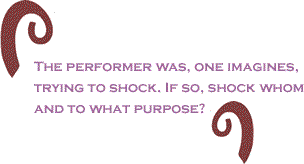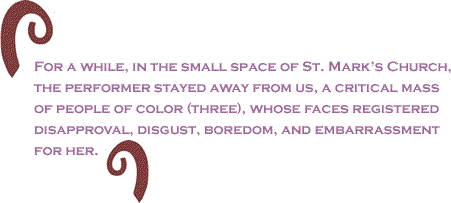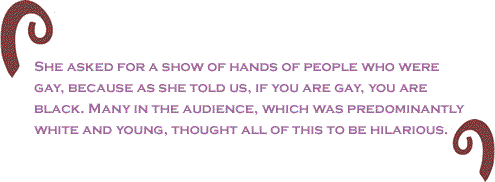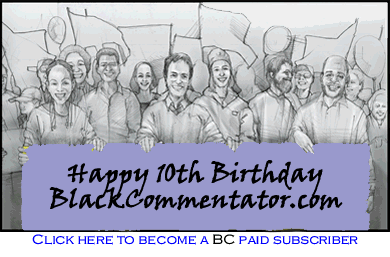In
Spike Lee’s film Bamboozled (2000), we get a powerful
close-up of a visibly distressed black performer applying
blackface. The tears are unscripted. Lee said that
the actors dreaded blacking up: they felt it was dehumanizing;
it tore out their souls. Recently, as part of a performance
at Danspace Project at St Mark’s Church, a white performer
blackened her face, declared herself black, and stated
quite simply, “I have been waiting my entire life
for this.”
Danspace
Project, a leading space for experimental contemporary
dance, just finished a two-month program that examined
the meaning of black dance. Curator and choreographer
Ishmael Houston-Jones asked, “[D]oes ‘Black Dance’
even exist? And assuming it does, what defines it?”
Thirty years ago, Houston-Jones first examined how
a new generation of black artists existed “in the
parallel worlds of Black America and of new dance.”
He reprised his eponymous 1982 program, Parallels,
and brought in many of the same choreographers, now
luminaries in the dance world, as well as a younger
generation: from Jawole Willa Jo Zollar to Ralph Lemon
to Nora Chipaumire. The series was routinely reviewed
and recommended, and garnered attention and acclaim.
On
February 18, 2012, in a program that examined the
intersections of black dance and postmodernism, choreographer
and multidisciplinary artist Dean Moss presented his
vision to an overflowing house. Moss invited three
younger artists to stage their work; he stated, “None
of them [are] African-American, but all of them are
Black.” Moss was attempting to de-essentialize black
as a biologically determined category, to look for
its meaning elsewhere. This is nothing new. There
is a long genealogy of thinkers—among them W.E.B.
Du Bois, Frantz Fanon, Stuart Hall—who have defined
blackness through its emergence in society; it’s an
historical and political consciousness that produces
resistant narratives to histories of oppression, slavery,
and colonialism and fights for a future of equality
and freedom. Blackness—race—is counterintuitive; it
exists because it is a response to the brutal fact
of racism.
What
an opportunity to present serious meditations on questions
that deeply undergird our society; however, as Houston-Jones
clearly understood, Moss’s program could also cause
controversy should any of the performers show up in
blackface. Quite predictably one of them did, challenging
her audience: “I am doing something that could be
offensive, right?” Yes. But why? Did the performer
know? Did her audience know?

That
evening at Danspace Project, Ann Liv Young, a performer
notorious for her irreverent exhibitionism, entered
in a flamingo pink dress, a black afro, and a face
painted black. The “post-dance” performance was mostly
a dialogue between performer and audience. The back
and forth was banal. A microphone in hand, the performer
engaged audience members. She asked, “Who are you?”
and received such stock responses as: I am German,
Italian, black (here the participant was not as exuberant).
Young said she was black because she had soul, and
someone retorted that her backside was black, though
in more colorful language. She asked for a show of
hands of people who were gay, because as she told
us, if you are gay, you are black. Many in the audience,
which was predominantly white and young, thought all
of this to be hilarious. Some of us thought differently:
it was mindless and inept. More disturbingly, the
minstrel show restaged the very categories it was
supposedly seeking to trouble: it trafficked in racist
stereotypes and behavior. If blackness is a revolutionary
consciousness, we were a far cry from its liberating
potential.
For
a while, in the small space of St. Mark’s Church,
the performer stayed away from us, a critical mass
of people of color (three), whose faces registered
disapproval, disgust, boredom, and embarrassment for
her. We had a choice: Do we leave, do we stay mute,
do we play along (which was not going to happen),
or do we say something even when we did not want to
become part of the act and its mechanical exploitation?
Halfway
through the performance, the performer saw me saying
something to my friend and approached us, demanding
to know what I had said. So I asked, “Could you please
tell us what the history of minstrelsy is in the United
States?” Needless to say, she did not know; she balked
at the question and became hostile. What ensued could
not have taken place in the streets or any other place,
I imagine. She screamed at the top of her voice: “This
is my performance, get out! Get Out!” One friend of
mine said we would be more than happy to, but we would
like our money back. That didn’t happen, nor did we
leave.
Her
attention was now fixed on us. She became (enacted
the role of?) a raging and racist lunatic. She came
within an inch of our faces and hurled obscenities
at us. There was no more laughter. A few people walked
out. Most people said or did nothing; the audience
was silent. We never raised our voices, never swore
back. She told me I was ugly and needed to look in
the mirror. I said, “I do, everyday, and I see a black
woman.” She said she looked in the mirror everyday
too. “Yes,” I said, “and you see a white girl.” And
the tables turned. She now invoked her Native American
bloodline; I think it was her great-great grandmother
who was Crow. And then, yes, her best friend was black,
or maybe it was her neighbor. Someone was black. She
began asking for testimonials from her friends in
the audience. These she received, as we were assured
that all was well, the performer was not a racist.
In a moment of blinding insight, one young man told
her: “They’re old, and they don’t understand what
you are doing.”
The
performance ended and two people came up to us (two
young men of color). One simply gave me a flower,
and the other reiterated what we had already heard:
“I know her; she’s really not a racist.” Perhaps not,
but by attempting to bamboozle her audience by manipulating
images without skill or knowledge, those images boomeranged
and we were all caught in a virulent web of hate and
racism.

The
performer was, one imagines, trying to shock. If so,
shock whom and to what purpose? “Epater la bourgeoisie.”
Flaubert’s dictum to the avant-garde. Yet, was this
minstrel show shocking or rather acceptable to a liberal
bourgeois audience in the East Village? I am certain
the performance could not have occurred in Harlem
with a predominantly black audience—bourgeois or not,
liberal or not. Why? Why does this matter? The New
York Times review of the performance sanitized and
sanctioned what happened. In a vanguard space, such
antics were deemed appropriate and having “purpose.”
Historically, the avant-garde understood shock as
a pact between the aesthetic and the political: shock
is a radical technique to propel revolutionary consciousness
and engagement. But if shock has no other purpose
than to shock, it can and does harm. In such cases,
there is no interruption, no rupture; rather, it both
enables and perpetuates the violence of the state,
the very thing avant-garde art attempts to critique
and displace. If this was an occasion to show different
visions for black dance, what occurred was a profound
failure of the political and aesthetic imagination.
Undoubtedly,
in a program that examines black dance, minstrelsy
and blackface have a role. In his catalog essay, Houston-Jones
explains that black dance has important roots in this
tradition, with 19th-century black dancers, such as
William Henry Lane, performing in blackface. The blackface
minstrel show was America’s first mass entertainment
industry and one of the earliest forms to expropriate
black culture. In the mid-19th century, when the beginnings
of a lucrative public entertainment sector began to
take shape in this country, the emerging class of
white professional entertainers gravitated to the
culture of the largely enslaved African population.
The dynamic entertainment value inherent in African
performance traditions—styles of movement, rhythm,
dance, song, and West African musical and oral traditions
of speech and language—were incorporated to invigorate
European forms. (Even today, only imagine what American
popular music would sound like without a black presence.)
This
kind of cultural appropriation could be seen as a
form of admiration, were it not for the pernicious
racist denigration in which it was cloaked. When imitating
and performing black material, these white performers
discovered a desperate need to disguise their indebtedness
behind the veil of contempt represented by blackface.
Not content merely to appropriate the culture for
profit, they created a number of devices and performance
conventions—alive and present among us to this day—for
the systematic humiliation and dehumanization of the
owners and creators of the culture on which the entertainers’
careers were based. Later black artists seeking the
public stage to perform their own cultural heritage
would be forced to parody themselves and compromise
their people’s dignity as the price of their admission.
Civil rights activist and scholar Ekwueme Michael
Thelwell writes: “What blackface gave rise to was
a sustained, protracted psychological assault on the
spiritual and intellectual life of an entire people.
Its origins, the manner and means of this assault
(while indeed compounding its long-term destructive
effects in the black community), reveal something
truly horrifying and instructive about the nature
and extent of the historical racism which deformed
the soul of white America.” It was a veil through
which black America encountered itself.
This
is an understated account of the cruel reality of
blackface; more so, when we understand that blackface
served as the handmaiden to both slavery and later
Jim Crow. Even through such a schematic history, the
concept of black dance is more clearly grasped. Houston-Jones
asked if black dance exists. We know the answer: black
dance must exist. The question then becomes how does
one responsibly present such material? Certainly not
with the arrogance to think that one could trump a
long history of divisive race relations in this country
by performing in blackface without any knowledge of
its history.

Spike
Lee resurrected the medium of blackface in Bamboozled.
Through meticulous research on and an understanding
of the history of minstrelsy, Lee gives a searing
critique of the ways in which stereotypical images
of black people have never stopped circulating in
our society. In the film, the dubious protagonist,
a black television writer, creates Mantan: The New
Millennium Minstrel Show. The show becomes a runaway
hit through the presentation of dancing and cooning
figures, such as Sleep ‘n’ Eat, Aunt Jemima, and Little
Nigger Jim. In the end, Lee poignantly shows how such
images harm everyone who comes into contact with them
as the film finishes with a literal dance of death,
and afterward, a montage of film clips of blackface
that breaks one’s heart.
In
his analysis of Bamboozled, scholar W. J. T. Mitchell
writes: “The virtuosity resides in the performances
of the actors, in their ability to move us from stereotype
to caricature to character and back again.” The New
York Times critic says of the Parallels performance
that it is best for the audience to realize that the
performer—“Sherry”—is a character and not risk getting
caught up in it. However, “Sherry” never reached the
level of character in her performance. Entirely the
creature of Young’s exhibitionism compounded by astonishing
bad judgment, she was always hovering between caricature
and racist stereotype. The critic was wrong when she
said, “Sherry always emerges unscathed.” What’s sad
is that even if we didn’t all realize it, we all emerged
scathed. As Mitchell states: “In the world of the
stereotype, everyone is both judge and judged, victim
and executioner. Putting on blackface […] is a dangerous
game that burns the flesh, and draws a divisive color
line not only around facial features but between persons,
and through the split psyches of the characters themselves.”
Post
Script
In
1993, a quarter century after the civil rights movement,
Ted Danson performed in blackface at the Friars Club,
a space in the city known for its risqué entertainment
and comedy. There were enough people in the audience
(many black) who were offended and angered, and an
apology was issued from the club. We are now almost
a half-century after the civil rights era, living
in a supposedly “post-racial” society. In an experimental
dance space—where Judy Hussie-Taylor, the executive
director of Danspace Project, invokes the importance
of an ethical practice in the introduction to the
Parallels catalogue—the clumsy, vulgar performance
of blackface to a mostly white audience seemingly
needs no discussion or apology. We are living in a
climate of permissive and willful ignorance, and what
occurred is symptomatic of a larger trend in society.
There are a set of tendencies and attitudes that are
gaining currency not only in art, but throughout the
United States that are denigrating black people—and
not only black people, but women, minorities, and
other vulnerable communities. We need to choose if
we allow them to flourish or if instead we responsibly,
ethically, hold them up to scrutiny—beginning in those
very spaces of art. There was once a time when the
avant-garde imagined the world otherwise and worked
to create an ethical and just life. Can we afford
to lose that?
This
commentary originally appeared in The
Brooklyn Rail.

BlackCommentator.com Guest Commentator Dr. Tanya Jayani
Fernando, PhD is an assistant professor of English
at the University of Massachusetts, Amherst. She is
completing a book on the avant-garde concept of shock.
She has written a play on dance, patronage, and race,
called Dance, Salome! Dance! Click here
to contact Dr. Fernando.
|

